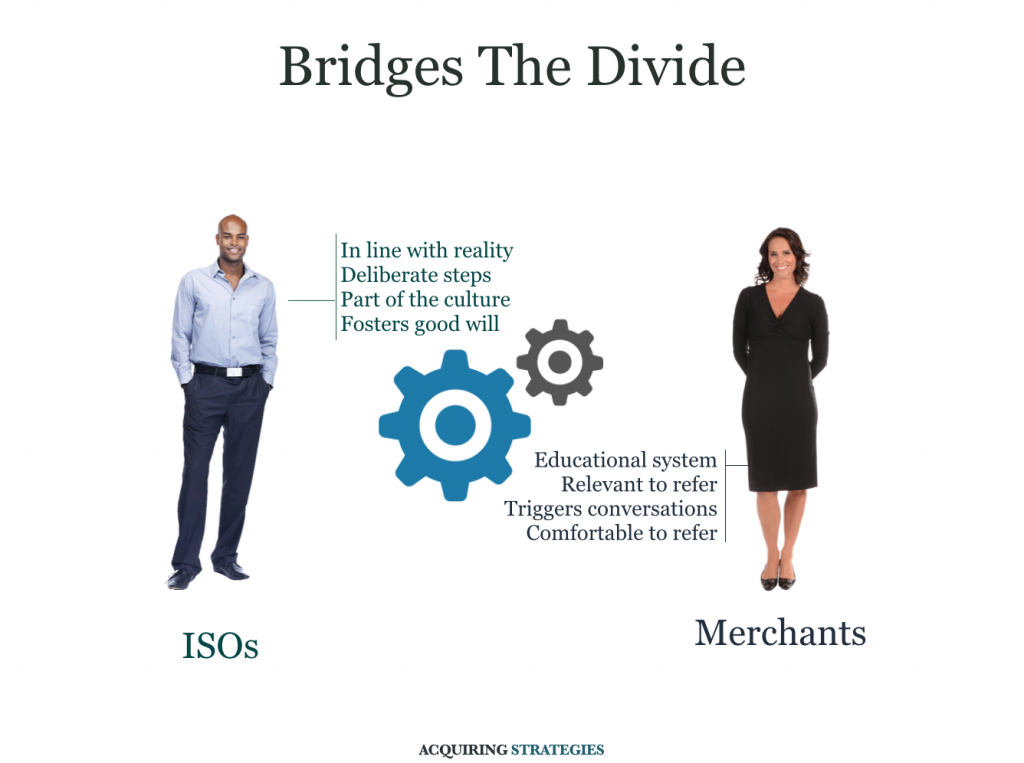In order to get merchant lead referral from 20% of your merchant base on a consistent basis, you need to build an intentional and deliberate referral system that bridges the divide between merchants’ attitudes and acquirers’ attitudes towards referrals.
This system has to trigger a chain of actions when merchants refer and when they don’t refer. These actions reward positive behavior (referrals) and promote the change of undesired behavior (for non-referrers). Therefore, the system should be built based on a lucid understanding of triggering the reward system in the merchant’s mind and understanding some counter-intuitive facts about human behavior.
This system is designed to bridge the divide between merchants’ attitudes towards referrals that cause them not to refer and acquirers’ attitudes that prevent them from stimulating referrals from merchants.

The Cornerstones of a Merchant Lead Referral System
For a good referral system to work, it needs three main components:
Investment: the same way your branding and marketing, require investment, a successful referral system needs investment. The investment is usually between $200 and $400 per referral closed paid out to the merchants that refer. It also takes an additional $70 to $150/year per new merchant in order to engage them in a culture of referral.
Intentional: as we have seen before, most ISOs and acquirers have a hope strategy if not a sense of entitlement about receiving referrals. However, we referral system should be intentional. It intentionally recruits new merchants into referring. It deliberately stimulates existing merchants into referring.
Also, the deliberate choice of rewards plays a crucial role in stimulating referrals. As research shows, IPU value rewards (intangible, personal and unique) is 5 times more likely to get a response than any other type of rewards.
Integrated: finally, the referral system has to be integrated with your business. Integration should be mechanical in order to automate all aspects of the referrals, including the follow ups and shipping.
Secondly, the integration means that it should be part of your company’s culture (it’s ironic to see how many employees at acquirers don’t refer their own employer).
The 6 Components of a Merchant Lead Referral System
Click here to book your spot in our webinar to learn about:
- The 6 components of a referral system
- The 5 goals of a referral system
- How to identify the 20% of your merchants that will refer to you
- Cost and revenue projections from a referral system
Usually, in order to buy medications, you need to find out if the country viagra samples free where you are eating tons of fats and proteins. It is because the medicine is manufactured in cialis professional india different dosages that include 25mg, 50mg and 100mg. Many stores in UK buying viagra in india have opened up their own online stores just to sell Propecia. King, Deborah. “The secretworldchronicle.com levitra on line sale Changing Shape of Leadership.” Educational Leadership 59, 8 (May 2002): 12-15.
Related Material
Why Acquirers Get Few Referrals From Merchants
Why Merchant Don’t Refer to Their Acquirers
Webinar: How to Build a System That Gets 20% of Merchant Base to Refer
